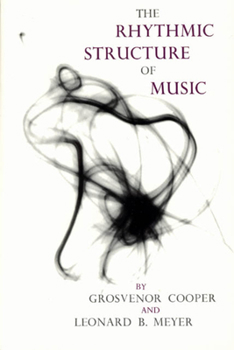The Rhythmic Structure of Music
Select Format
Select Condition 
Book Overview
In this influential book on the subject of rhythm, the authors develop a theoretical framework based essentially on a Gestalt approach, viewing rhythmic experience in terms of pattern perception or groupings. Musical examples of increasing complexity are used to provide training in the analysis, performance, and writing of rhythm, with exercises for the student's own work. "This is a path-breaking work, important alike to music students and teachers, but it will make profitable reading for performers, too."-New York Times Book Review "When at some future time theories of rhythm . . . are . . . as well understood, and as much discussed as theories of harmony and counterpoint . . . they will rest in no small measure on the foundations laid by Cooper and Meyer in this provocative dissertation on the rhythmic structure of music."-Notes ". . . . a significant, courageous and, on the whole, successful attempt to deal with a very controversial and neglected subject. Certainly no one who takes the time to read it will emerge from the experience unchanged or unmoved."-Journal of Music Theory The late GROSVENOR W. COOPER, author of Learning to Listen, was professor of music at the University of California at Santa Cruz.
Format:Paperback
Language:English
ISBN:0226115224
ISBN13:9780226115221
Release Date:April 1963
Publisher:University of Chicago Press
Length:221 Pages
Weight:0.65 lbs.
Dimensions:0.5" x 6.0" x 8.9"
Customer Reviews
1 rating
Worthy Effort
Published by Thriftbooks.com User , 24 years ago
Here Cooper and Meyer take on the nature of rhythm in music, using a system of relationships between accents and unaccented or lesser accented notes based on poetic feet. It is one of the very few attempts to discuss rhythm (beyond a basic categorization such as simple/compound; duple/triple)--that it is not, perhaps, completely successful should not entirely invalidate the effort, or indeed, the achievement. Certain topics are not entirely well-explained. I remember that as a student I asked Professor Meyer the difference between two particular terms used in the book--his answer was that he could no longer remember (this was probably 15 years after the book was written) and that the distinction no longer seemed important to him. True, the book was jointly authored and perhaps this distinction was never fully convincing to Meyer--I don't know. In spite of this, the book is truly important for introducing and discussing the concept of form as a rhythmic idea. That rhythm, like pitch, can have hierarchic structures may at first seem counterintuitive; but Cooper and Meyer make a convincing arguement. And that after some 35 years this book is still in print and has not been superceded speaks volumes.






